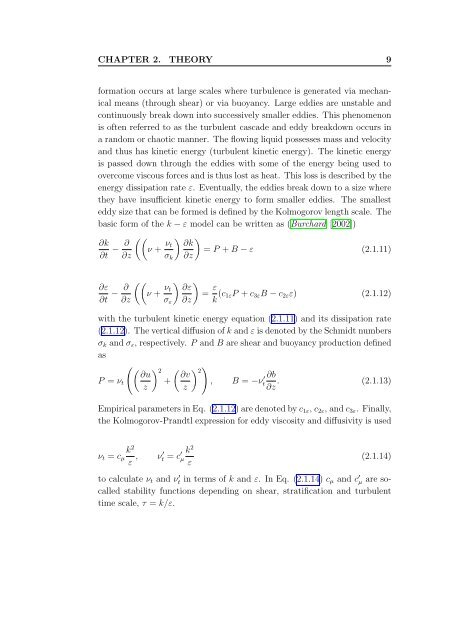Three-dimensional Lagrangian Tracer Modelling in Wadden Sea ...
Three-dimensional Lagrangian Tracer Modelling in Wadden Sea ...
Three-dimensional Lagrangian Tracer Modelling in Wadden Sea ...
Create successful ePaper yourself
Turn your PDF publications into a flip-book with our unique Google optimized e-Paper software.
CHAPTER 2. THEORY 9<br />
formation occurs at large scales where turbulence is generated via mechanical<br />
means (through shear) or via buoyancy. Large eddies are unstable and<br />
cont<strong>in</strong>uously break down <strong>in</strong>to successively smaller eddies. This phenomenon<br />
is often referred to as the turbulent cascade and eddy breakdown occurs <strong>in</strong><br />
a random or chaotic manner. The flow<strong>in</strong>g liquid possesses mass and velocity<br />
and thus has k<strong>in</strong>etic energy (turbulent k<strong>in</strong>etic energy). The k<strong>in</strong>etic energy<br />
is passed down through the eddies with some of the energy be<strong>in</strong>g used to<br />
overcome viscous forces and is thus lost as heat. This loss is described by the<br />
energy dissipation rate ε. Eventually, the eddies break down to a size where<br />
they have <strong>in</strong>sufficient k<strong>in</strong>etic energy to form smaller eddies. The smallest<br />
eddy size that can be formed is def<strong>in</strong>ed by the Kolmogorov length scale. The<br />
basic form of the k − ε model can be written as (Burchard [2002])<br />
∂k<br />
∂t<br />
− ∂<br />
∂z<br />
��<br />
ν + νt<br />
σk<br />
� ∂k<br />
∂z<br />
�<br />
= P + B − ε (2.1.11)<br />
��<br />
∂ε ∂<br />
− ν +<br />
∂t ∂z<br />
νt<br />
� �<br />
∂ε<br />
=<br />
σε ∂z<br />
ε<br />
k (c1εP + c3εB − c2εε) (2.1.12)<br />
with the turbulent k<strong>in</strong>etic energy equation (2.1.11) and its dissipation rate<br />
(2.1.12). The vertical diffusion of k and ε is denoted by the Schmidt numbers<br />
σk and σε, respectively. P and B are shear and buoyancy production def<strong>in</strong>ed<br />
as<br />
��∂u �2 � � �<br />
2<br />
∂v<br />
P = νt + , B = −ν<br />
z z<br />
′ ∂b<br />
t . (2.1.13)<br />
∂z<br />
Empirical parameters <strong>in</strong> Eq. (2.1.12) are denoted by c1ε, c2ε, and c3ε. F<strong>in</strong>ally,<br />
the Kolmogorov-Prandtl expression for eddy viscosity and diffusivity is used<br />
k<br />
νt = cµ<br />
2<br />
ε , ν′ t = c ′ k<br />
µ<br />
2<br />
ε<br />
(2.1.14)<br />
to calculate νt and ν ′ t <strong>in</strong> terms of k and ε. In Eq. (2.1.14) cµ and c ′ µ are socalled<br />
stability functions depend<strong>in</strong>g on shear, stratification and turbulent<br />
time scale, τ = k/ε.

















